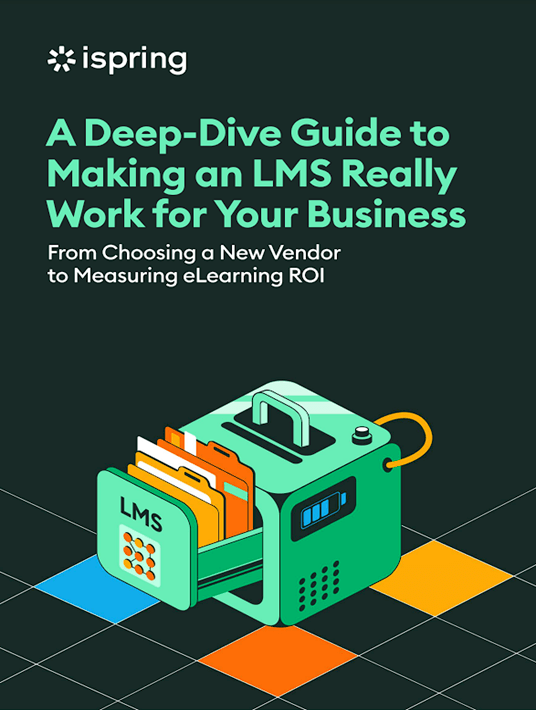
LMS Return On Investment: A 3-Step Measurement Guide
Return On Investment (ROI) is one of the most critical metrics for evaluating the success and value of your training programs. LMS ROI shows how much return you get from the system compared to the cost of implementing and running it. The higher the ROI, the more value the LMS is providing to your business.

eBook Release
A Deep-Dive Guide To Making An LMS Really Work For Your Business
Whether you’re new to LMSs or want to get more out of your current platform, this guide will help you make your investment worthwhile.
Here’s a simple 3-step guide to measuring your LMS Return On Investment.
Step 1: Calculate The LMS Costs
Assess the expenditures associated with implementing and maintaining the training platform. LMS costs typically include:
- Initial needs assessment. Amount to be spent on evaluating your training needs and selecting the appropriate LMS.
- License/subscription fees. Ongoing costs for purchasing or accessing the LMS software are usually billed on a monthly or annual basis.
- Implementation costs. Expenses for setting up the LMS, including configuration, customization, and data migration.
- Training costs. Costs to train administrators and users how to use the LMS effectively.
- Maintenance and support. Fees for ongoing technical support, software updates, and system maintenance.
- Content development. Costs associated with creating or purchasing training materials and courses to be delivered via the LMS.
Combine all the expenses, and you’ll get the total cost of your LMS.
| Expert Insight Remember that the total sum of your LMS costs depends heavily on the size of the company and the scope of your training needs. Selecting an LMS with scalable features can help you manage expenses as your training programs grow and evolve. This way, you can ensure that your investment remains as cost-effective as possible. According to iSpring’s recent research on the state of corporate training in 2024, 40% of organizations spent less than $50,000 on employee training last year. So chances are, your LMS-associated expenses will fall within this range.
Natalie Taylor |
Step 2: Determine And Quantify The LMS Benefits
This step is a little more complicated. LMSs offer multiple benefits to businesses, but it’s impossible to measure every single advantage precisely in terms of monetary value. Unquantifiable LMS benefits can include:
- Improved organizational structure.
- Increased employee engagement and satisfaction.
- Enhanced employee creativity.
- Better corporate and HR branding, etc.
Keep these gains in mind to have a full understanding of the return you get from investing in a learning management solution.
However, to calculate the tangible ROI, focus on the most significant quantifiable benefits that align with your training goals and business objectives. These usually include:
- Increased productivity. Measure the time employees used to spend learning and managing training programs and compare it to the current metrics. Then, calculate the monetary value of this saved time based on employee salaries. You’re likely to see a substantial increase in productivity, thanks to the training automation and streamlined processes associated with the use of an LMS.
- Training cost savings. Compare the expenses of traditional training methods, such as travel, venue booking, and printed materials, with the costs of an LMS. Measure the monetary difference to see how much you save by moving training programs to a digital platform.
- Improved compliance. An LMS helps ensure that employees complete mandatory training on time, reducing the risk of non-compliance penalties. To calculate this benefit, assess the costs associated with non-compliance incidents before and after implementing the LMS, including fines, legal fees, and lost productivity, and compare them to see the savings and improved compliance rates.
- Employee retention rates. Use this metric if you regularly record employee retention rates at your organization. Compare the turnover rates before and after implementing the LMS and estimate the savings from reduced hiring and onboarding costs, along with the gains in productivity from retaining experienced employees.
- Enhanced performance metrics. Track relevant KPIs related to your eLearning programs, such as sales figures, customer satisfaction scores, or production rates before and after training. Compare the improvements in these metrics to quantify the impact of the LMS on overall performance.
Calculate the sum of quantifiable LMS benefits to see your overall gains.
Step 3: Calculate The LMS Return On Investment
Calculating the LMS ROI is fairly straightforward. Use the following formula:

Where Net Benefits = Total Benefits – Total Costs.
LMS ROI Calculation Example
Let’s examine the process of measuring LMS Return On Investment at a mid-sized company.
An enterprise invests $80,000 in an LMS, comprising:
- $15,000 for the initial setup.
- $30,000 for customization and integration.
- $10,000 for training.
- $25,000 for the initial annual subscription fee.
The benefits include:
- $50,000 in increased productivity.
- $15,000 in cost savings from reduced travel.
- $20,000 due to improved compliance.
- $15,000 from enhanced performance.
These numbers boil down to:
- Total costs: $80,000.
- Total benefits: $100,000.
- Net benefits: $20,000.
When we apply the formula to the company’s numbers, we get a 25% LMS ROI.

Use this protocol to measure the training ROI at your organization and to ensure that your investment in the LMS is delivering tangible benefits, optimizing training effectiveness, and supporting your overall business goals.
Want To Learn More About Making The Most Of Your LMS?
Download A Deep-Dive Guide To Making An LMS Really Work For Your Business today to navigate the entire process of effective Learning Management System implementation and use.

